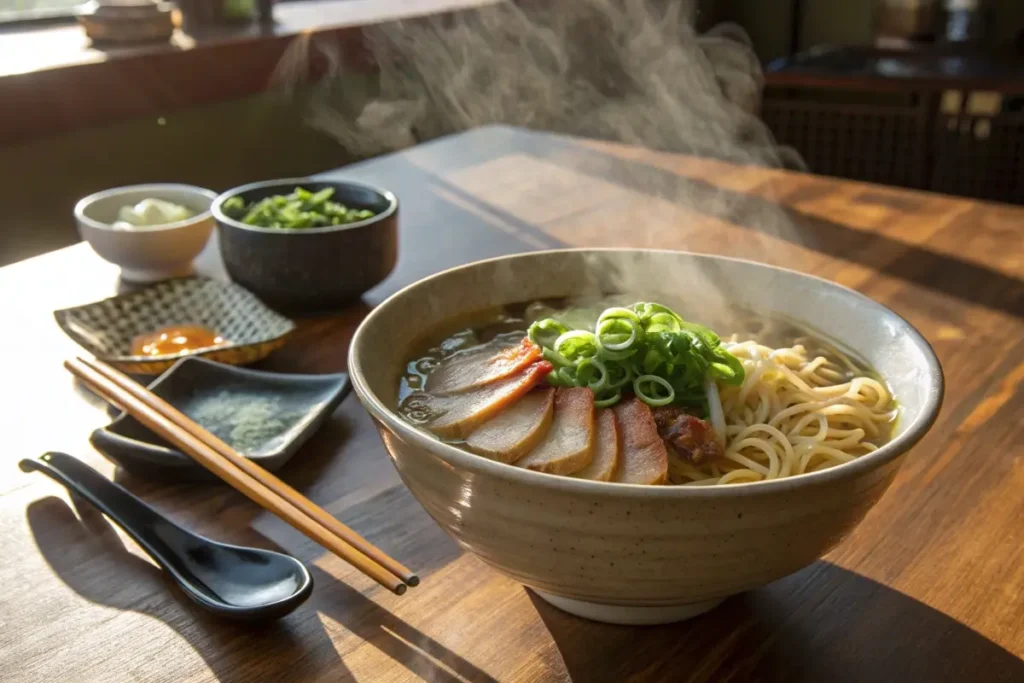Few dishes encapsulate comfort and tradition like a steaming bowl of ramen. Yet, the large ramen bowl itself often goes overlooked despite its crucial role in presentation, temperature control, and overall dining experience. A Japanese ramen bowl isn’t just about capacity; it’s an artful blend of design, material, and functionality. Whether you’re perfecting ramen and bowls at home or serving hungry customers in a restaurant, understanding the nuances of ceramic ramen bowl sizes, shapes, and aesthetics can elevate every slurp. So, what size is a large ramen bowl? Typically, anywhere from 800 ml to 1500 ml, ensuring ample room for noodles, broth, and toppings without spillage.
If you’ve wondered how Korean ramyun bowls or pho bowls differ, or simply want to discover the best ramen bowls for your kitchen, this guide sheds light on all aspects of these iconic vessels.
Ready to dive deeper? We’ll explore bowl capacities, shapes, cultural distinctions, and how to choose the perfect one to complement your ramen creations. We’ll also compare other noodle dishes (like pho or Korean ramyun) to show where a large ramen bowl excels. By the end, you’ll not only know how big a 1000 ml bowl is but also how to pick a durable, stylish design—be it for home or restaurant ramen bowl setups. For additional ways to pair your new bowl with delicious Japanese-inspired recipes, check out our Japanese Chicken Fried Rice Recipe as a hearty side or companion dish. Let’s unlock the secrets of the perfect large ramen bowl.
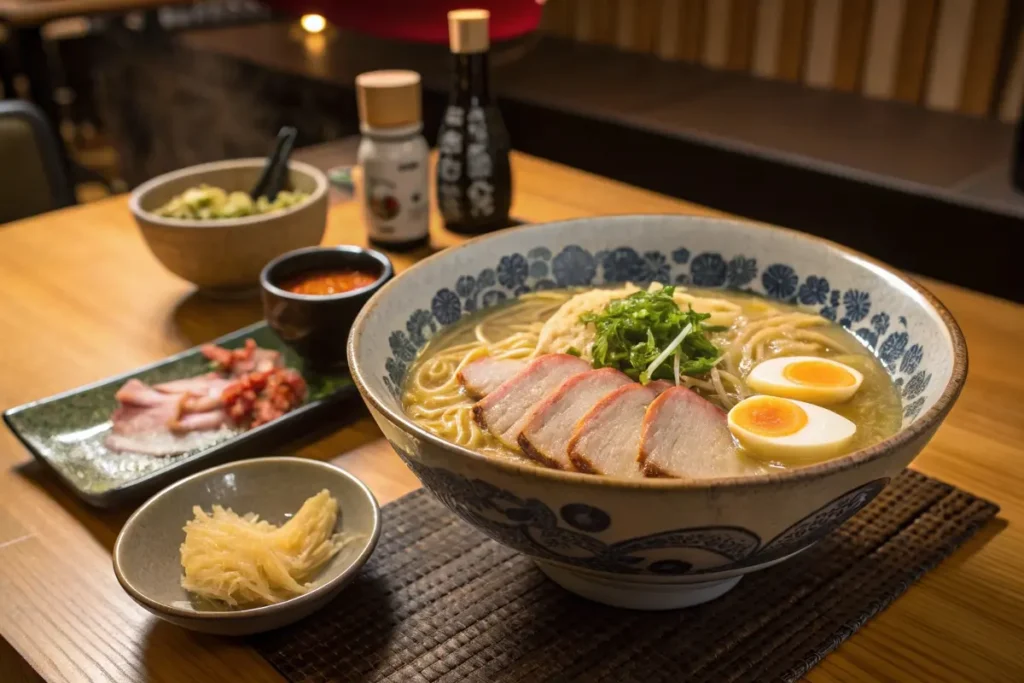
Table of Contents
Understanding the Large Ramen Bowl
1.1 What Qualifies as “Large”?
When discussing the large ramen bowl, capacity usually starts around 800 ml and can extend up to 1500 ml. These measurements matter. Ramen typically includes a substantial volume of broth and noodles, plus toppings like chashu, bamboo shoots, or marinated eggs. Having enough space ensures you can stir, slurp, and savor without fear of spillage. If you’ve ever had a cramped bowl, you know the struggle—hot broth brimming at the rim leaves no room for comfort.
Reference Points
- What size is a large ramen bowl? Many chefs consider 1000 ml (about 34 ounces) a sweet spot, offering a satisfying portion.
- For those wanting massive servings (especially in certain restaurant ramen bowl contexts), 1200 ml or more can house extra noodles and larger cuts of meat.
1.2 Purpose and Function
Unlike standard soup bowls, ramen and bowls revolve around retaining heat. Thick ceramic or melamine helps keep soup hot while you work through the toppings. A broad rim and deep interior allow for layering. You can nest noodles below and display toppings above, encouraging diners to see the artistry. Another advantage: The shape fosters spoon-friendly edges for scooping broth and enough room for chopsticks to maneuver easily.
1.3 Materials and Heat Retention
- Ceramic Ramen Bowl: A classical choice. Ceramic retains heat well and often showcases elegant glazes or patterns.
- Melamine or Plastic: Lightweight and more break-resistant—common in bustling restaurants. However, they might lose heat faster compared to heavier ceramics.
- Porcelain or Stoneware: Similar to ceramic but can be slightly more durable or have different aesthetic finishes.
1.4 Cultural Roots
Why is a large ramen bowl so culturally significant in Japan? Traditional ramen embraces hearty portions meant to leave diners satisfied. In many ramen shops, a bigger bowl conveys generosity. The aesthetic aspect—often featuring patterns inside or swirling designs—enhances the overall dining experience, especially as you near the bowl’s bottom. For instance, a hidden logo or motif might appear after sipping away half the broth, adding an element of discovery.
1.5 Modern Trends
From artisanal potters crafting best ramen bowls with minimalistic glaze, to mass-produced melamine sets, the market brims with variety. Home cooks love upgrading from a generic soup bowl to a specialized ramen vessel, aligning with the global rise of Japanese cuisine. In fact, the line between restaurant ramen bowl and home usage is blurring—people crave authenticity in their kitchens. If you’re into other Japanese staples, you might also enjoy pairing your large ramen bowl with recipes from our Japanese Curry Recipe One Piece for a complete comfort food spread.
Ultimately, the large ramen bowl addresses a practical need (volume and heat retention) while doubling as a cultural statement piece. Whether you’re brandishing a richly decorated ceramic piece or a sturdy melamine version, the sense of tradition merges with convenience, ensuring every noodle-laden spoonful remains piping hot and visually irresistible.
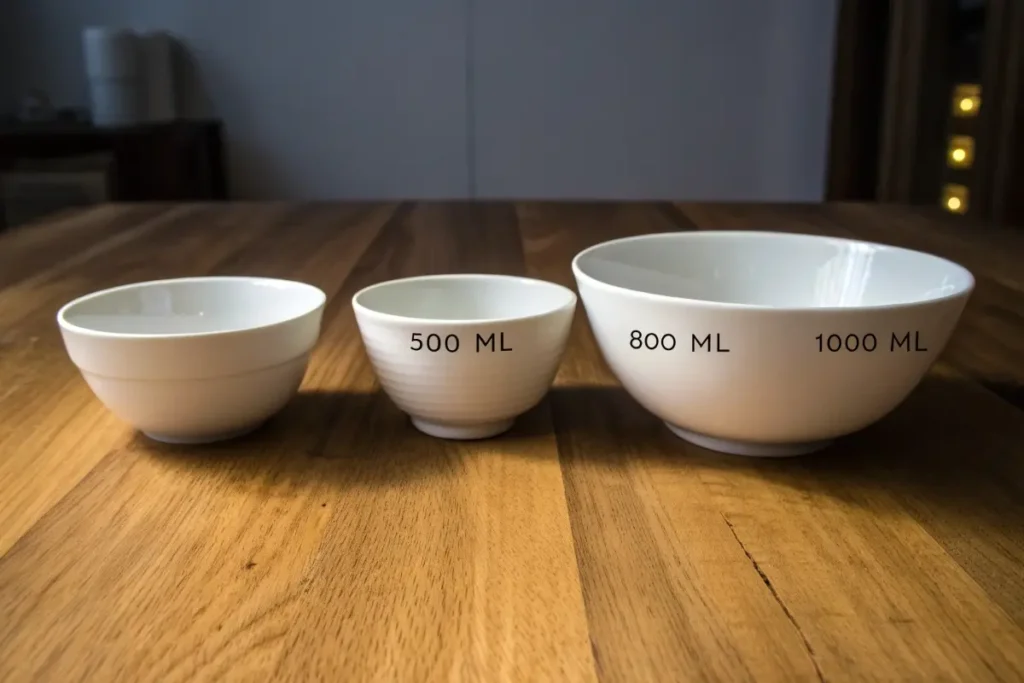
Different Materials & Their Impact
2.1 Ceramic vs. Porcelain vs. Melamine
While we lump ceramic and porcelain under “ceramic ramen bowl,” subtle distinctions exist:
- Ceramic: A broad term often signifying earthenware or stoneware—slightly thicker, can feature rustic glazes. Great for artisanal flair.
- Porcelain: Fired at higher temperatures, usually smoother, more delicate in appearance, but can still be robust. Lighter than stoneware.
- Melamine: A synthetic resin-based material, lighter to handle, shatter-resistant, often used in fast-paced restaurant ramen bowl environments.
2.2 Heat Retention and Durability
- Earthenware: Absorbs and maintains heat well but can be prone to chipping if mishandled.
- Porcelain: Balanced conduction and retention—sleek and refined.
- Melamine: Doesn’t hold heat as effectively, but it’s tough to break, making it child-friendly or ideal for busy diners.
For a home setting, you might prefer the cozy weight of ceramic or porcelain. If you’re throwing a ramen party with multiple guests, melamine ensures safe stacking and minimal breakage risk. If you also cook dynamic recipes, consider exploring our Japanese Scallop Recipe for synergy with your new dishware—those plump scallops nestled into a large bowl of noodles is a treat for both palate and eyes.
2.3 Design Aesthetics
The large surface area invites decoration. Traditional motifs might include waves, dragons, or calligraphic text. Modern or minimalist styles may show subtle glazes or a single accent color. The interior design can matter: a pattern at the bowl’s base adds an element of fun as you devour the broth. Meanwhile, a pronounced rim might be easier to grip. Look for slip-resistant bottoms if you’re worried about sliding on certain surfaces.
2.4 Maintenance and Cleaning
- Ceramic: Generally dishwasher-safe, though handwashing preserves decorative glazes. Avoid abrupt temperature changes (from freezer to boiling water, for instance) to prevent cracking.
- Melamine: Often dishwasher-safe. However, it’s not microwave-friendly, so watch out if you reheat noodles.
- Porcelain: Typically safe for microwaving if it lacks metallic embellishments. Yet delicate pieces might chip with heavy use.
2.5 Restaurant vs. Home Requirements
Restaurant: Crisp longevity, minimal breakage, and fast cleaning cycles. Chefs or staff handle dozens daily, so melamine or thick porcelain might be standard.
Home: If you want an Instagram-worthy display or to replicate an authentic ramen bar vibe, invest in a high-quality, stylized ceramic ramen bowl. The heavier weight and curated pattern can enchant guests. Don’t forget matching spoons or chopsticks to complete the set.
When deciding, weigh how you’ll store them. Large bowls require ample cupboard space. If you’re short on storage, a stackable design might help. Also note the practical details: Are they safe for oven use if you plan to keep soup warm? Do they accommodate a standard ladle comfortably? For a deeper dive into Japanese cooking fundamentals that might factor into bowl usage, see our Discover Japanese Recipes resource. After all, your new bowl is only as good as the dishes it presents.
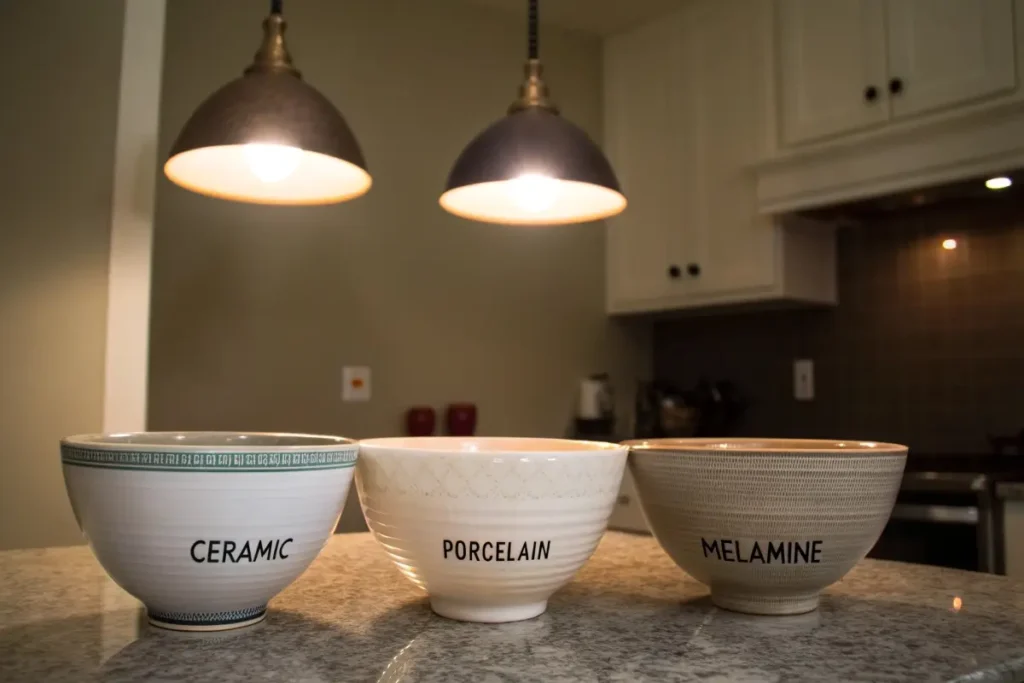
Size & Dimensions – 1000 ml & Beyond
3.1 Standard Volume Range
Large ramen bowls typically hold around 800-1200 ml, though some can reach 1500 ml. How big is a 1000 ml bowl? In simple terms, it’s big enough to comfortably cradle a standard portion of ramen (roughly 6-8 oz noodles, 12-16 oz broth) plus toppings. This extra capacity ensures the toppings float freely without pushing broth over the rim. If your ramen style includes extra chashu or large vegetables, you might want 1200 ml or more.
3.2 Diameter & Depth
- Diameter: Larger bowls often measure 8-10 inches across. This broad surface exposes more of the broth to air, aiding cooling for slow eaters.
- Depth: Typically 3-4 inches. The deeper shape helps corral all the fixings and keeps them hot. Some prefer a slightly shallower bowl for simpler scooping, while deeper forms cater to robust soup-based dishes.
3.3 Handling and Ergonomics
A large circumference can be tricky to handle when filled with scorching broth. Many Japanese ramen bowls have a gentle curve, allowing easier gripping from beneath or at the rim’s edge. Some incorporate a small foot or ring at the base for stability—helping you tilt the bowl at the end for that final sip of broth. If you’re enjoying a bowl of thick miso ramen or hearty tonkotsu, the bowl’s shape can also accentuate the aroma.
3.4 Ramen vs. Pho vs. Korean Bowls
Ramen Bowl vs. Pho Bowl
- Pho bowls often appear slightly narrower but tall, optimizing the swirl of thin rice noodles. Ramen bowls can be wider to accommodate the robust array of toppings, from marinated eggs to bean sprouts and seaweed.
- Japanese ramen bowl exteriors are frequently decorative. Pho bowls might be simpler and mostly white in restaurants.
Korean Ramen Bowl
- In Korea, instant ramyun is sometimes served in lightweight metal bowls for quick heating. Traditional earthenware pots (ttukbaegi) are used for other stews or soups. If you see the question What is the Korean ramen bowl called?, it’s not a single universal term—metal bowls or earthenware might be used, each with unique names.
- Some prefer the iconic golden aluminum pot for instant noodles, but that’s more casual than the elaborate shapes for Japanese ramen.
3.5 The 1000 ml Benchmark
A 1000 ml capacity is a balanced “one-size-fits-most” approach: large enough for standard ramen but not unwieldy. Whether you’re planning miso, shoyu, or tonkotsu, you can comfortably garnish with egg halves, menma (bamboo shoots), or even add a portion of fried chicken katsu. For an adventurous twist, you can explore our Japanese Chicken Curry Recipe and try a curry ramen fusion, ensuring your large bowl can handle thicker broths and extra toppings.
3.6 Visual Proportions
From a plating perspective, a wide rim helps you arrange toppings in a visually pleasing manner—an essential factor if you’re entertaining or running a ramen pop-up. Also, the ratio of noodles to broth should remain consistent: about 70% capacity when everything’s in. That leaves enough space for steam to circulate without overflow.
Ramen vs. Other Noodle Dishes
4.1 Ramen & Bowls – The Unbreakable Bond
Ramen’s hallmark is a hearty, flavor-packed broth surrounding chewy wheat noodles. The bowl’s design and size reflect that synergy: a wide brim for toppings, enough depth for swirling chopsticks. If you tried using a small, standard soup bowl, you’d likely end up with splashes or insufficient room for classic add-ons like seaweed sheets or narutomaki fish cake.
4.2 Pho and Rice Noodles
Pho, originating from Vietnam, uses rice noodles and a different style of broth—often lighter, aromatic with star anise, and garnished with fresh herbs. A large ramen bowl can still hold pho, but the typical pho bowls in restaurants are narrower, focusing on quick scooping of thinner noodles. Meanwhile, ramen’s bouncy wheat noodles require more space to manipulate. Some might argue that pho, with its fresh basil, bean sprouts, and lime wedges, could also benefit from wide bowls. Ultimately, it’s personal preference and visual aesthetics.
4.3 Korean Ramyun
Korean ramyun bowls often center on quick, convenient cooking: instant noodles simmered in a simple pot, sometimes served directly from the pot. If you want a more refined approach for homemade jjajangmyeon or spicy shin ramyun with extra vegetables, a large ramen bowl works wonders. It’s robust enough to handle thick sauces or red-pepper-laden broths. Also, in some Korean restaurants, you might see double-handled earthenware for soups. That differs from the single large bowl approach typical in Japanese style.
4.4 Udon and Soba
Though distinct from ramen, udon and soba noodles also rely on deeper bowls. Udon can be quite thick, so a large bowl prevents lumps. Soba might be served cold (zaru soba), but if hot, an ample bowl makes slurping comfortable. So if you’re investing in a best ramen bowls set, they can easily double up for other Japanese noodle favorites.
4.5 Culinary Crossovers
Fusion is popular. Maybe you want to serve Thai tom yum or Chinese dan dan noodles in your large ramen bowl. There’s no rule forbidding it—the shape is equally beneficial for swirling thick noodle dishes from various cuisines. Some might question authenticity, but practicality often wins out. For instance, a hearty bowl of Taiwanese beef noodles or a big portion of Chinese wonton noodles might also flourish in a wide, deep ramen bowl.
For more creative noodle dishes or side recipes you could adapt to ramen bowls, check out our Vegetables Japanese Recipe for miso-glazed veggies that can top your soup. Ultimately, the essence of a large ramen bowl isn’t just restricted to ramen—it’s a versatile vessel bridging multiple noodle traditions.
Choosing & Caring for the Best Ramen Bowls
5.1 Factors to Consider
- Material: Ceramics retain heat best but can chip. Melamine is practical for high-traffic usage or kids.
- Volume: Start around 800 ml if you’re making moderate portions. If you want truly hearty bowls, aim for 1000 ml or more.
- Design: Do you want a classic Japanese pattern, a minimalist matte black finish, or whimsical modern prints?
5.2 Comfort & Grip
Bowl shape influences how easily you can tilt it to sip the last of the broth. A footed base can keep your table from scorching if you pour in near-boiling soup. Ramen connoisseurs often prefer a slight curvature near the rim that fits chopsticks or a large ramen spoon.
5.3 Storing & Stacking
- Stackable bowls: Handy if you own multiple large bowls. Some sets nest inside each other for efficient storage.
- Handling: Glazed exteriors might slip in damp hands. Look for a slightly unglazed or textured ring for secure handling.
5.4 Tips to Extend Lifespan
- Avoid Thermal Shock: Don’t move a piping-hot bowl directly to a cold surface or fill a cold bowl with boiling water abruptly.
- Gentle Washing: For intricately glazed pieces, avoid harsh abrasives. If you rely on a dishwasher, ensure it’s top-rack safe.
- Mind the Microwave: Some ceramic or porcelain bowls with metallic accents are not microwave-friendly. Always check manufacturer guidelines.
5.5 Price Ranges
A basic melamine or mass-produced ceramic might run around $10-$20, while handcrafted artisan bowls could exceed $50 or $60 each. If you’re building a top-notch home ramen station, investing in a quality set can significantly enhance the meal’s visual and tactile enjoyment.
5.6 Pairing Accessories
- Chopsticks: Wood or bamboo pairs well with ceramic. Some prefer fiberglass for durability.
- Ramen Spoon (renge): A broad-lipped spoon that cradles broth and noodles. Usually, it rests on the bowl’s rim or has a small hook on the handle to prevent slipping.
- Soup Ladle: For portioning out hot broth into each bowl if you’re serving a crowd.
- Lid or Cover: Rare but might come in handy if you want to transport or keep your noodles warm for a bit longer.
If you’d like to see how a large ramen bowl fits into broader Japanese cuisine, you might explore our Japanese Chicken Curry Recipe—some folks love using bigger bowls for soupy curry udon or curry ramen hybrids. Ultimately, caring for your chosen bowl ensures longevity and repeated nights of comforting, slurp-worthy dinners.
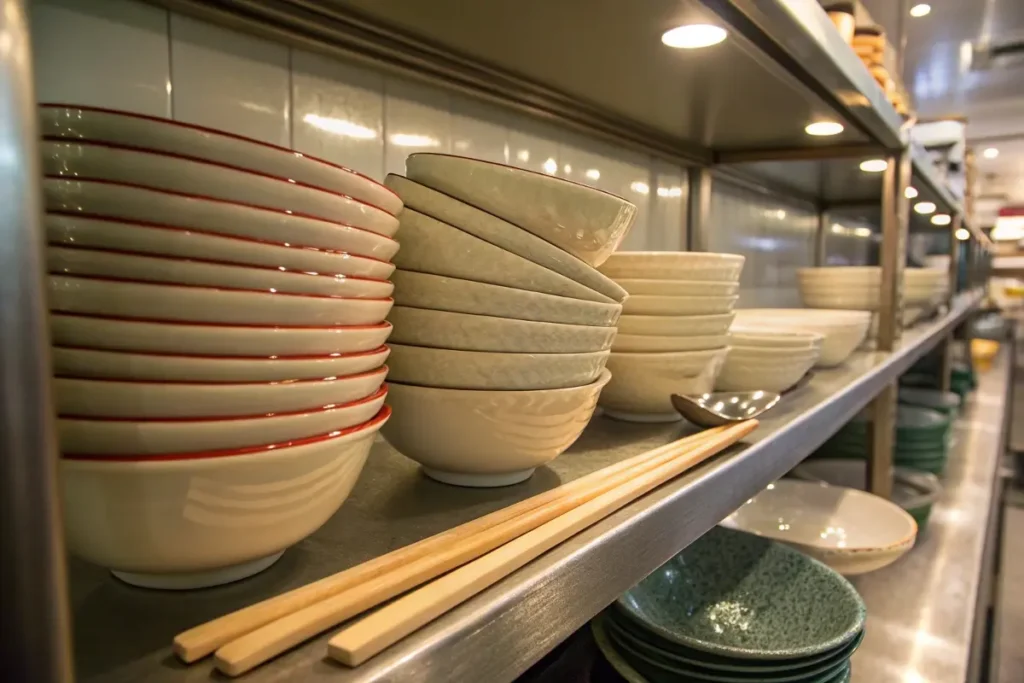
History/Context
Evolution of the Ramen Bowl
Ramen’s origins trace back to Chinese-style noodles introduced to Japan. Over time, Japan transformed these influences into various ramen styles—shoyu, tonkotsu, miso, shio—each culminating in region-specific traditions. But the bowl itself also evolved in tandem with the dish. Historically, smaller, shallow bowls sufficed for simpler soups. As ramen soared in popularity in post-war Japan, large bowls became standard to accommodate generous portions and hearty broths favored by laborers seeking an affordable, filling meal.
Ceramic Workshops
In pottery hubs like Arita or Mino, artisans developed specialized techniques to create robust, heat-retaining vessels. These factories or workshops recognized the restaurant market’s appetite for visually appealing, durable pieces. Intricate patterns (e.g., waves, dragons, or geometric lines) flourished, blending beauty with function. Some potters derived designs from centuries-old tea ceremony bowls or donburi bowls, adapting them to ramen’s needs.
Cultural Significance
Ramen culture boomed in the 20th century, morphing from a street food staple to a revered culinary art. The large ramen bowl became symbolic of generosity and satisfaction—finishing your bowl signaled respect to the chef. In bustling ramen-ya (ramen shops), staff would line up row upon row of big bowls, quickly ladling broth while the diner’s seat had just been occupied. The dramatic size resonated with Japanese dining culture, emphasizing abundance and communal enjoyment.
Global Spread
As ramen shops expanded globally, from Tokyo to New York, Los Angeles, and beyond, the concept of a large, signature bowl spread too. Western diners quickly appreciated the lavish aesthetic of swirling noodles, bright toppings, and aromatic broth all in one expansive vessel. Meanwhile, some restaurants introduced fusion versions—like ramen with Tex-Mex toppings or Southeast Asian spices—yet the big bowl format remained constant.
Contemporary Craft
Today, “ramen mania” continues, with artisanal shops and chain restaurants alike. Bowls range from minimalistic matte black to swirl-glazed showpieces. Social media fosters a wave of “food porn” snapshots emphasizing wide-bowled presentations brimming with color. The popularity of large ramen bowl designs is no fluke: social shares reward visual drama, while diners relish the comfort of generous helpings.
If you’re intrigued by other facets of Japanese culinary evolution, see our Traditional Japanese Desserts Recipe for how sweet dishes integrated modern twists while retaining local charm. Much like these desserts, the large ramen bowl itself stands at the intersection of heritage, innovation, and global appeal.
Practical Examples/Use Cases
1. Home Noodle Parties
Scenario: You’re hosting friends for a ramen night.
- Approach: Provide each guest with a large ramen bowl. Lay out broth, noodles, proteins (chashu, chicken, tofu), and toppings buffet-style. Everyone assembles custom bowls.
- Benefit: Eliminates fear of overfilling a small vessel. Guests can swirl noodles freely. A visually enticing setup encourages creativity.
2. Restaurant Presentations
Scenario: You run a ramen shop or fusion eatery.
- Approach: Order a set of sturdy but visually striking restaurant ramen bowl designs—perhaps melamine for quick service or signature ceramics for an upscale vibe. Feature your best-seller ramen in these bowls with brand-specific patterns at the base.
- Outcome: Elevates brand identity. Customers perceive larger portions, boosting perceived value.
3. Photogenic Food Blogging
Scenario: You’re a food blogger capturing intense ramen “pull shots” (lifting noodles from the bowl).
- Approach: A wide, shallow Japanese ramen bowl ensures you can spread toppings elegantly for bright photos. The diameter frames your composition better.
- Upshot: Eye-catching images that pop on social media, showcasing swirl patterns and topping layers.
4. Noodle Testing & Recipe Development
Scenario: You’re developing new ramen recipes with experimental broths or non-traditional toppings.
- Approach: The large volume allows measuring consistent noodle-to-broth ratios. You have space to test garnish combos without crowding.
- Advantage: Facilitates systematic recipe iteration. If you find a winning combination, you can replicate it easily—just fill the bowl to the same level each time.
5. Holiday or Themed Gatherings
Scenario: Incorporate Japanese cuisine in holiday events.
- Approach: Serve a special miso ramen with seasonal vegetables or turkey slices (for a unique Thanksgiving spin) in large bowls.
- Result: Memorable feast bridging cultural cuisines. For more holiday inspiration, see our article on What Foods Do Japanese People Eat for Thanksgiving if you’re curious about fusion ideas.
No matter the situation—home, restaurant, or creative exploration—large ramen bowls bring convenience and aesthetic flair. Their generous capacity fosters immersive experiences: swirling noodles, layering garnishes, and capturing appetizing images. The synergy of form and function truly shines in these use cases.
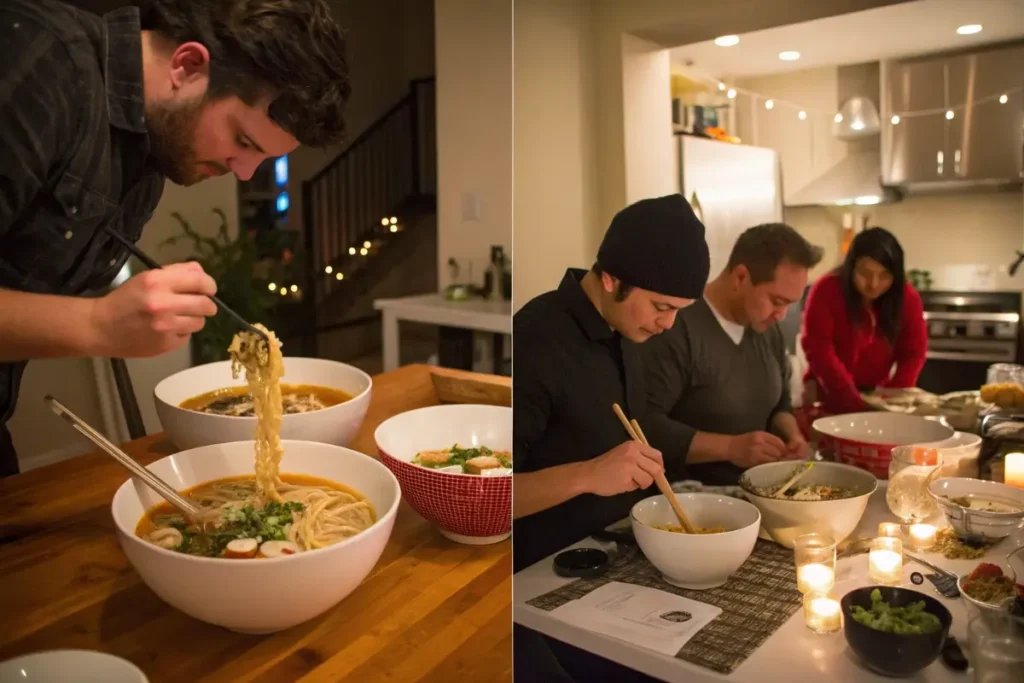
FAQs
1. What size is a large ramen bowl?
A standard large ramen bowl holds between 800 ml to 1200 ml of liquid, with 1000 ml considered a common midpoint. This range ensures ample room for broth, noodles, and toppings without spillage.
2. What is the difference between a ramen bowl and a pho bowl?
Ramen bowls are typically wider and sometimes deeper to accommodate thick wheat noodles and abundant toppings. Pho bowls can be narrower or more cylindrical, focusing on thin rice noodles. Both are large, but the shape and typical design features vary based on cultural preferences.
3. What is the Korean ramen bowl called?
There isn’t a single universal name. Many Korean eateries might simply use a metal or earthenware bowl, especially for instant ramyun. Alternatively, they employ earthenware pots (like ttukbaegi) for soups. If referencing specialized designs akin to Japanese ramen bowls, some might just call them “ramyun bowls,” but it’s less standardized.
4. How big is a 1000 ml bowl?
A 1000 ml bowl usually has about an 8- to 9-inch diameter and 3- to 4-inch depth, though designs differ. It’s generally enough to hold one hearty portion of ramen, with space left for stir-ins, toppings, and comfortable spoon or chopstick movement.
5. Do large ramen bowls keep soup hot longer?
Yes—especially ceramic or stoneware ones. Their thicker walls and shape insulate heat, so your broth remains steamy while you eat.
6. Are large bowls harder to clean or store?
They can be if you have limited cabinet space. However, many are stackable, and dishwasher-safe models simplify cleaning.
7. Can I use a large ramen bowl for other dishes?
Absolutely. These bowls are versatile for soups, udon, pasta, or even hearty salads. The roomy design suits many meals beyond ramen.
Conclusion
A large ramen bowl isn’t just a container—it’s part of the culinary ritual that makes ramen so comforting and visually appealing. From the 1000 ml sweet spot to oversized 1500 ml behemoths, choosing the right capacity, shape, and material influences every spoonful you enjoy. Whether you’re plating a classic shoyu ramen at home or running a bustling restaurant ramen bowl operation, the synergy of size, design, and material ensures each bowlful remains satisfying from the first bite to the final slurp.
Investing in high-quality bowls might feel like a small detail, but it’s one that pays off. Their ample diameter ensures toppings float or rest neatly, while thick walls retain heat for leisurely dining. If you’re ready to explore further, or looking for dishes to pair with your new bowls, check out our Japanese Fried Rice Recipe as a side dish or a creative filler. Remember: the essence of ramen goes beyond the noodles and broth—presentation plays a pivotal role, and your bowl is the literal foundation of that experience. Next time you savor a hot, aromatic bowl, take a moment to appreciate the craft and capacity that make it unforgettable.
